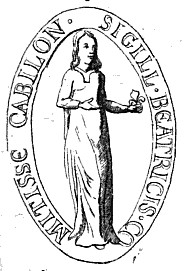Beatrice of Albon facts for kids
Béatrice, Countess of Albon and Dauphine of Viennois (born in 1161, died in 1228) was a powerful ruler in her time. She became the Countess and Dauphine in 1162, when she was just a baby, after her father, Guigues V of Albon, passed away. This meant she was in charge of a large and important area in what is now southeastern France.
Béatrice's Role as a Ruler
Béatrice was not just a countess by title; she actively ruled her lands. The title "Dauphine of Viennois" was very special. It was given to the rulers of a region called the Dauphiné. This title later became linked to the heir to the French throne, similar to how the Prince of Wales is the heir in England. Béatrice was one of the first women to hold such a significant ruling position in medieval Europe. She managed her territories, made decisions, and helped keep peace and order.
Family and Legacy
In 1183, Béatrice married Hugh III, Duke of Burgundy. Their marriage was important because it connected two powerful families. Together, they had three children who would continue their family's legacy:
- André Guigues VI (1184–1237): He became the next Dauphin of Viennois, following in his mother's footsteps.
- Mahaut (1190–1242): She married John I, Count of Châlon and Auxonne in 1214. This marriage helped strengthen alliances with other noble families.
- Marguerite (1192–1243): Around 1217, she married Amadeus IV, Count of Savoy. The Counts of Savoy were very important rulers in the Alps region, so this marriage further expanded the family's influence.
Béatrice's long rule, from 1162 to 1228, helped bring stability to her lands. She is remembered as an important female ruler in medieval history who successfully managed her territories and ensured her family's future through strategic marriages.
See also
 In Spanish: Beatriz de Albon para niños
In Spanish: Beatriz de Albon para niños


